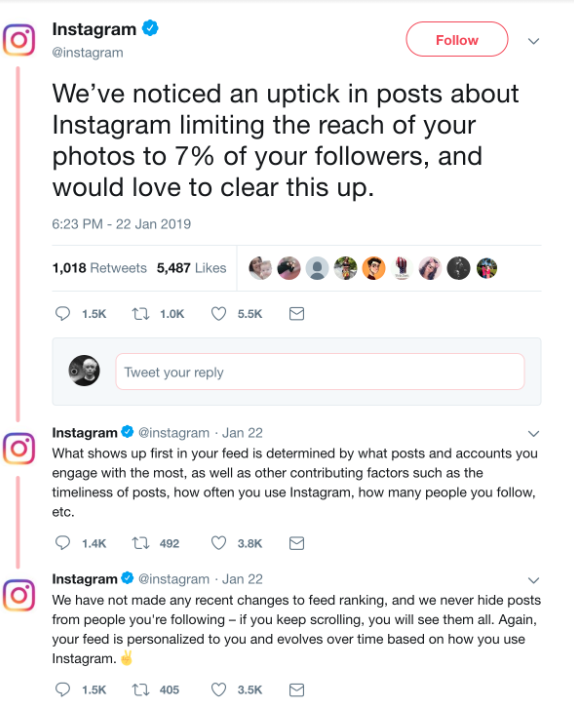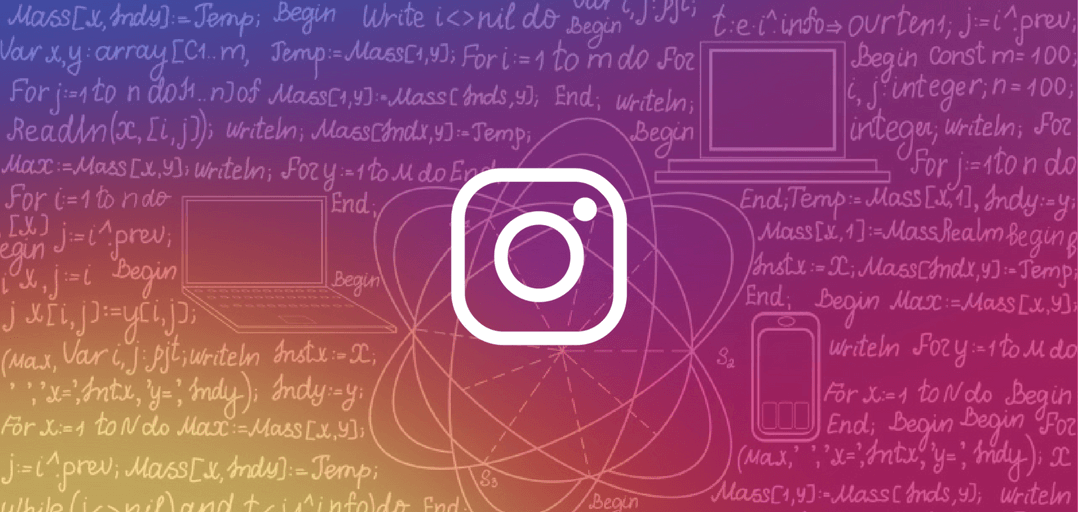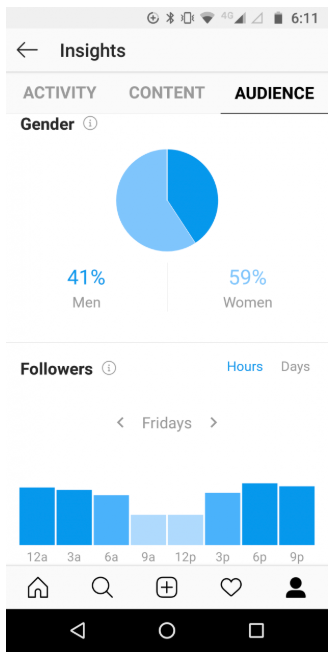Instagram algorithm changes affect everybody who uses this platform: brands, Kardashians, you, and yes, your mother.
However ever since Instagram nixed the reverse-chronological feed in 2016, rumors have flown about what the Instagram algorithm is, does, and cares about. It’s a mysterious beast, and misinformation abounds.
So how could your brand make sure you are fine-tuning your Instagram marketing strategy so that you are working with the flow of the feed, and not against it?
Here, we have gathered the most up-to-date info (and debunked the newest conspiracy theories) about the all-powerful algorithm.
How the Instagram algorithm works in 2019
First off: no, it is still not reverse-chronological. (Though it does prioritize “timeliness”—however, we will get to that in a second.)
Here’s the thing to keep in mind: Instagram’s primary purpose is to maximize the time users spend on the platform. Because the longer users linger, the more adverts they see. So directly or indirectly, accounts that assist Instagram to achieve that purpose are rewarded.
However, that’s a pretty broad statement. And it’s simple to misinterpret.
To help clear up misconceptions, in June 2018 Instagram invited journalists to a press briefing in San Francisco, where their product group explained how the algorithm works.
Particularly, product lead Julian Gutman went into detail on how the algorithm uses “ranking signals” to decide the way to arrange each individual user’s feed.
Instagram’s top 3 ranking signals
1. Relationship
Instagram’s algorithm prioritizes content from accounts that users interact with a lot.
If a person usually leaves comments on your posts, or if they’ve notifications enabled for your account, or you DM each other, or you tag each other in your posts, then the algorithm recognizes that the two of you’re “close.”
According to Instagram, this set-up permits users to see 90 % of posts from their “family and friends.” Back when feeds were organized in reverse-chronological order, Instagram estimates people missed 50 % of these necessary posts and 70 % of their feed overall.
2. Interest
The algorithm additionally predicts which posts are necessary to users based on their past behavior. This potentially contains the use of machine vision (a.k.a. image recognition) technology to assess the content of a photo.
That is similar to how the Facebook algorithm and the YouTube algorithm filter and recommend content. So, users who like latte art are more likely to see latte art at the top of their feed. Users who like baby animals are more likely to see baby animals up there.
3. Timeliness
The algorithm illustrates users newer posts first, according to this announcement from March 2018. We’d guess that this was in response to the endless marketing campaign for a return to the reverse-chronological feed.
For brands, the timeliness (or “recency”) ranking signal means that paying attention to your audience’s behavior, and posting once they’re online, is vital.
Other Instagram algorithm factors
Instagram additionally acknowledges other factors that affect the way the algorithm organizes each individual’s feed.
Frequency of use
This relies on how often a user opens the app. The algorithm goals to point out users the best and most prevalent posts since they last looked at their feed.
Following count
If a user follows lots of accounts, they will probably see fewer posts from any one particular account, even if that account is prolific. However, they will see a wider breadth of posts overall. However, if they follow a smaller number of accounts, they will likely see more of each account’s posts.
Usage, a.k.a. session time
A user who spends 45 minutes on Instagram will go deeper into the back catalog and see more posts (by which we mean underperforming posts) than a user who scans for 5 minutes and catches only the best hits.
5 myths about the Instagram algorithm
1. Reverse-chronological isn’t coming back

Users will continue to campaign, and journalists will continue to ask, however, Instagram (at least as of this writing) stands company.
2. There is no shadowban
Paranoia about the so-called “shadowban” has been rolling around on marketing blogs for years. According to Instagram, it does not exist. The algorithm isn’t capable of hiding your content without telling you.
That mentioned, sudden declines in engagement are definitely possible in case your followers are annoyed by spammy practices.
So pay attention to the community guidelines. And definitely use Instagram hashtag best practices.
3. The reach cap is fake news, too
Most recently, in January 2019, Instagram took to Twitter to rehash some details.

This is the same story as the shadowban. Users who feel like their activities are toeing past the line of worth and into spamminess feel guilty. Then they’ve paranoid fantasies that the algorithm—who’s omniscient like Santa Claus—is persecuting them.
Alas, no. In case your reach has taken a sudden turn, it’s greatest to investigate factors within your control.
4. Using Stories or going Live won’t make the algorithm like you more
The feed is the feed, according to Instagram. And the feed’s algorithm does not discriminate based on how often your account makes use of other instruments within the app.
Though in case your brand’s use of Stories and Live video is jaw-dropping, you are likely to get more followers and engagement from your audience overall. So we do recommend including these tools as a part of your Instagram business plan.
5. Verified users don’t get particular treatment (and neither do business accounts)
If it looks like they do, that’s truly a feature of the algorithm prioritizing the content’s popularity. No particular kind of account gets a head start: the users decide what they want, and the algorithm delivers it.
8 tips to make the Instagram algorithm work in your favor
1. Post more often
When you think your group has the capacity to rise quality and quantity, go for it.
It used to be that it was dangerous to publish to Instagram more than once a day. You do not want to be that brand. However, since the algorithm automatically breaks up multiple pictures to diversify what people see, your audience could not even consciously register the rise. And when you are posting great content, they will probably like it.
Utilizing an Instagram scheduling tool to plan out your content calendar will make managing a rise in posting volume a whole lot simpler.
2. Post video
According to Instagram, the algorithm does not prioritize video unless your audience prioritizes video. Somebody who never pauses to watch videos will see fewer of them on their feed.
However, statistically, most people probably will stop to watch. (Video consumption on Instagram increased 80 % year over year from 2018). That leaves the algorithm tasked with the job of discovering more videos for these users to watch.
Posting videos—whether Live, as a Story, or on IGTV—will also enhance the time your audience spends with each post, which may result in increased engagement.
3. Post when your audience is looking
Reverse-chronological is not coming back (I swear, that’s the last time I will mention it), however because the algorithm favors recent posts, brands need to pay attention to when their audiences are online.
We suggest utilizing an Instagram scheduler to a) get access to more advanced analytics than Instagram offers, and b) get these posts out at the right time without dropping everything at 4 pm (or 4 am, in case your audience is in another hemisphere).
In the meantime, we did an analysis of Instagram’s top 20 North American brands and came up with data on the best time of the day and week to publish on Instagram, sorted by industry.
4. Be personable
The algorithm will promote your posts to users who have a relationship with you already. To build these relationships up authentically. (No, we aren’t talking about Instagram pods.)
Write compelling captions to drive engagement. Chat with people in the comments, ask questions. Like other people’s posts, and touch upon them. Easy, but efficient.
5. Use hashtags well
The aim of a hashtag is to make your post accessible to people who could not essentially follow you, however, who have an interest in your areas of expertise.
Hashtag misuse is a good way to make your brand look desperate and slimy. (Yes, even when you hide them under the fold: we see that.) Instead, use hashtags in good religion. Like a librarian would use them: first, to genuinely make clear what your put up is about. Second, to do your half to assist arrange the info torrent to your viewers.
6. Run a contest for a fast increase
One of many quickest, however nonetheless professional, methods to gasoline up your engagement and make good with the algorithm is to run an Instagram contest.
Contests take some preparation. They usually additionally have to be well-thought-out in the event that they’re going to construct your model and never tarnish it. However because the algorithm eats and breathes consideration, there’s no higher strategy to court docket it.
An easy giveaway that options your flagship services or products could effectively cement you in your viewers’ good graces, develop your followers, and carry your engagement to the purpose the place the algorithm can’t assist however take notice.
7. Encourage individuals to activate notifications
When done the right approach, (i.e., reminding people casually), that is one method to impress the algorithm with your brand’s importance to your group. People who have notifications turned on won’t solely be extra likely to engage with your posts, they’ll additionally see extra content material from you general.
8. Make your posts really unimaginable
Instagram has stated repeatedly that the one strategy to carry your content material’s feed rating is to provide nice content material.
In the meantime, the attraction of Instagram has all the time been the unwritten rule that nobody posts crappy pictures. (Okay, virtually nobody.)
So in case your abilities—and engagement—have plateaued, it’s time to strive one thing different. Why not rent an expert photographer, and see what you’ll be able to study? Or obtain some new instruments and learn to edit photos like a pro.


